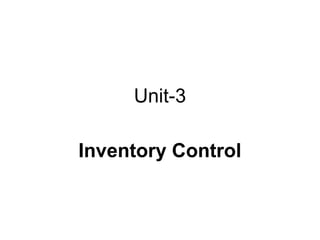
Lecture17,18,19,20
- 2. Introduction to Inventory • Inventory is defined as the list of movable goods which helps directly or indirectly in the production of goods for sale. Inventory is service to production. • Inventory may also be defined as a comprehensive list of movable items which are required for manufacturing the products and to maintain the plant facilities in working conditions.
- 3. Inventory DefinitionInventory Definition • A stock of items held to meet future demand • It can be defined as the stock of goods, commodities or other resources that are stored at any given period of future production
- 4. Types of Inventory Inputs • Raw Materials • Purchased parts • Maintenance and Repair Materials Outputs • Finished Goods • Scrap and Waste Process In Process • Partially Completed Products and Subassemblies (in warehouses, or “in transit”) (often on the factory floor)
- 5. Classification Of Inventories • Inventory can be classified as: 1.Direct inventories:- which play a direct role in the manufacture of a product and becomes an integral part of the finished product are called direct inventories. 2.Indirect inventories :- are those materials which help the raw materials to get converted into the finished products, but do not become an integral part of the finished products.
- 6. Direct Inventories 1. Raw Materials :- are those basic materials from which components, parts & products are manufactured by the company. 2. In Process Inventories( work in progress):- are the semi-finished goods at various stages of manufacture. 3. Purchase parts 4. Finished goods
- 7. Indirect Inventories 1. Tools:- various tools like Standard tools , Hand tools 2. Supplies :- it includes materials used in running the plant but do not go into the product . Supplies include :- • miscellaneous consumable stores such as brooms, cotton waste, vim powder . • General office supplies such a s candles , pencils , pens etc. • Ledgers & journals , Electric supplies etc.
- 8. Inventory Control • Inventory control refers to the process whereby the investment in materials & parts carried in stock is regulated within predetermined limits set in accordance with the inventory policy established by the management. • Inventory control aims at maintaining the values of the inventories at the lowest possible level at the same time seeing that the required inventories are available at all items.
- 9. Reasons To Hold InventoryReasons To Hold Inventory • Meet variations in customer demand: – Meet unexpected demand – Smooth seasonal or cyclical demand • Pricing related: – Temporary price discount – Take advantage of quantity discounts • Process & supply surprises – Internal – upsets in parts of or our own processes – External – delays in incoming goods
- 10. Reasons To NOT Hold InventoryReasons To NOT Hold Inventory • Increases Carrying cost – Financially calculable • Takes up valuable factory space – Especially for in-process inventory • Inventory covers up “problems” … • Wastage of materials • Increase in Maintenance cost
- 11. Determining Inventory Level 1. Order quantity 2. Lead time 3. Safety stock - Extra inventory is needed to protect against unreliable forecast & protection against stock outs. 4. Reorder point - It is pre-known that it takes days between initiating the order & receiving the required quantity.
- 12. Lead Time • There is always some interval between the time the need for the material is determined & the time the material is actually received . This period is known as lead time . It consists of requisition. It consists of Requisition time ( Rt )+ Procurement time(Pt). • Requisition time consists of time required to prepare purchase requisition & placing the order to a selected vendor. • Procurement time - time for the seller to get or prepare the inventory for dispatch & time for inventory to be dispatched from the supplier & to reach the customer.
- 13. Inventory costs • Inventory analysis identifies 4 major cost components: 1.Purchase cost 2.Ordering cost 3.Carrying cost – Direct & Indirect cost 4.Stock out cost
- 14. Purchase cost • This refers to the nominal cost of inventory. It is the purchase price for the items that are bought from outside sources, and the production cost if the items are produced within the organization Ordering Cost/ setup Cost • Ordering cost is incurred whenever the inventory is replenished. It includes costs associated with the processing & chasing of the purchase order, transportations, inspection for quality, expediting overdue orders & so on. It is also known as “procurement cost”
- 15. Carrying cost Direct Cost • Capital costs • Storage costs • Service costs Indirect Cost • Risk costs • Incremental increase in infrastructure Costs
- 16. Stock-out costs • Stock out cost means the cost associated with the not serving the customers . Stock out implies shortages . Other types of cost in inventory control are • Warehousing Costs • Damage & obsolescence cost